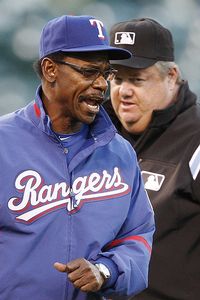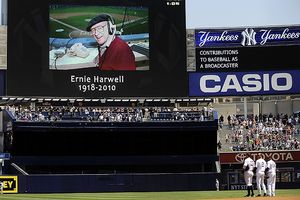Ron Washington flips the pages of his three-ring notebook, filled with inside info on the other team's pitchers and hitters.
The Texas manager gets to the back of the black binder, reaches into the pocket and pulls out another scouting report -- on that night's home plate umpire.
[+] Enlarge

AP Photo/Ben MargotRon Washington, reacting to his ejection by crew chief Joe West last Monday, said technology has made a difference in how teams can scout umpires.
It's a color-coded computer printout showing his strike zone -- how he tends to call balls and strikes -- and whether he usually gives the pitcher a break if the ball sails just off the corner of the plate.
In this ump's case, the calls on the edges are too inconsistent to be predictable.
"We do have their tendencies in the dugout on the wall. The name of the umpire and his tendencies, what they call and what part of the zone they call strikes," Washington said.
"When I was playing, we just knew he was a high-ball umpire or a low-ball umpire, whether he was a pitcher's umpire or a hitter's umpire," he said.
The difference now?
"Technology," Washington said.
For years, baseball teams have scouted the opposition -- which pitch is most effective against a certain batter, which catcher has a strong throwing arm, and the like.
Now teams are taking it to a different level by scouting the umpires -- compiling information on how consistently they call balls and strikes, how quick they are to eject someone arguing a call, where the crew comes from, the next time they're next in town.
The Rangers aren't the only ones taking advantage, either. Several teams track umpires on a daily basis and provide their players with the detailed reports.
Here's how one team assessed Hunter Wendelstedt: "Inconsistent zone, both in-game and from game-to-game, seemingly losing focus at times by balling pitches over middle and calling strikes on pitches well off plate. Seems to want hitter to put ball in play."
Or this look at Gerry Davis: "Hesitates to punch hitters out. Towards the top of the league in umpire ERA in 2009, with low K and low BB rate in 2009 and has continued in 2010. Need to earn strikes with him behind the plate."
In other words, the report says Davis is reluctant to call strike three when a batter doesn't swing.
Some teams attach headshots of the crew, along with a short bio about each of the four umpires. Such as this nugget on Marty Foster: "Attends as many Wisconsin Big Ten football games as possible."
And this about Ed Hickox: "Is a sworn police officer in offseason, working as a detective for the Daytona Beach Shores Police Dept."
“
We like to get the players to know who's going to be there, get to know them and give them a little bit of background, so the players can say hello.
”-- Athletics manager Bob Geren
"It's just more of a reference to get to know them better, a communication tool," Oakland manager Bob Geren said. "We like to get the players to know who's going to be there, get to know them and give them a little bit of background, so the players can say hello."
"We keep umpire media guides in the dugout. Guys feel uncomfortable if they go out and don't know who they are -- and we have a lot of young players," he said.
Advance scouts sometimes prepare the reports. Other clubs rely on watching video. Stat services and websites also compile the numbers.
"There's so much more data on umpires and it's much easier to track their balls-strikes calling. Guys have more specific reputations because the data is better," Oakland director of baseball operations Farhan Zaidi said.
Exactly how many teams do it is hard to say -- at least a couple of clubs declined to directly answer whether they scout umpires, or they dodged the question.
At Fenway Park last week, longtime crew chief John Hirschbeck shook his head when shown a team's scouting report on a different set of umpires.
"I'm surprised, but I guess I'm not surprised," he said. "Everyone is looking for an edge."
"We try to call every pitch the same way. The stats, those can depend on the matchup, who's pitching that day," he said. "Luck of the draw."
Even though baseball's rule book precisely defines the strike zone, umpires could vary in how they interpret it -- not easy in a game where the pitch frequently comes in at more than 90 mph and can dip several inches at the last split second.
To James Hoye, the personal tidbits and pictures made more sense than the strike zone tendencies. He's working his first full season as a major league umpire, with Wally Bell and Laz Diaz on Hirschbeck's crew.
"Instead of asking Wally the name of the guy who's at second base, they can see for themselves," Hoye said.
Atlanta manager Bobby Cox said the Braves don't chart the umps. But he could understand why a team would: "If it helps to win one ballgame a year, it's not a waste of time. Might get you to the playoffs."
It could come down to a single pitch, and how it's handled. Here's what one team posted about Jerry Layne: "Seems very influenced by a catcher's receiving." That refers to a catcher's practice of subtly moving his mitt back into the strike zone after catching a close pitch.
Here's a line from the report on how umpire Fieldin Culbreth reacts on a full-count: "Seems to expand zone on 3-2, as he punches out hitters he normally calls a ball in different counts."
Asked for comment on the practice of scouting, Culbreth, who is on the board of directors of the umpires' union, the World Umpires Association, said: "I'd rather not get involved in that. It doesn't matter."
Los Angeles Dodgers bench coach Bob Schaefer said such reports could result in information overload.
"I mean, it's tough enough for a hitter to look at a pitcher and see what the pitcher's trying to do to him. So you'd clog everything up if you worry about the umpire," he said.
The Toronto Blue Jays certainly keep tabs.
"Every umpire that comes into town, whether at home or on the road, we have their tendencies. We know what type of umpires they are," hitting coach Dwayne Murphy said.
"They have that information. I'm not sure which site or where we get it from, but that information is there. They all have it," he said.
That's news to many people.
"I never heard of that. That's very interesting," Detroit manager Jim Leyland said.
Wondered Florida manager Fredi Gonzalez: "Do people do that? Maybe I'm missing the boat; you tell me. I haven't. Who has done that? I want to ask them. Maybe it'll help us win another game or two."
Washington pitcher Craig Stammen's first reaction was: "Huh? That's smart." Nationals teammate Livan Hernandez got wide-eyed. "I never heard of that," the pitcher said.
Neither had Milwaukee outfielder Jim Edmonds. "It's probably not a bad idea. It's an interesting concept," he said.
Told that Texas kept umpire charts, veteran A's star Eric Chavez chuckled. Ron Washington, a former Oakland coach, got ejected by Joe West during the recent Rangers-Athletics series.
"When Wash came out to argue the other day, he didn't read his reports," Chavez kidded. "Maybe he should do his homework."
Philadelphia Phillies to hold J.A. Happ out of next startPellegrini salutes RonaldoMessi has no Premier plansRonaldo calm ahead of Clasico























